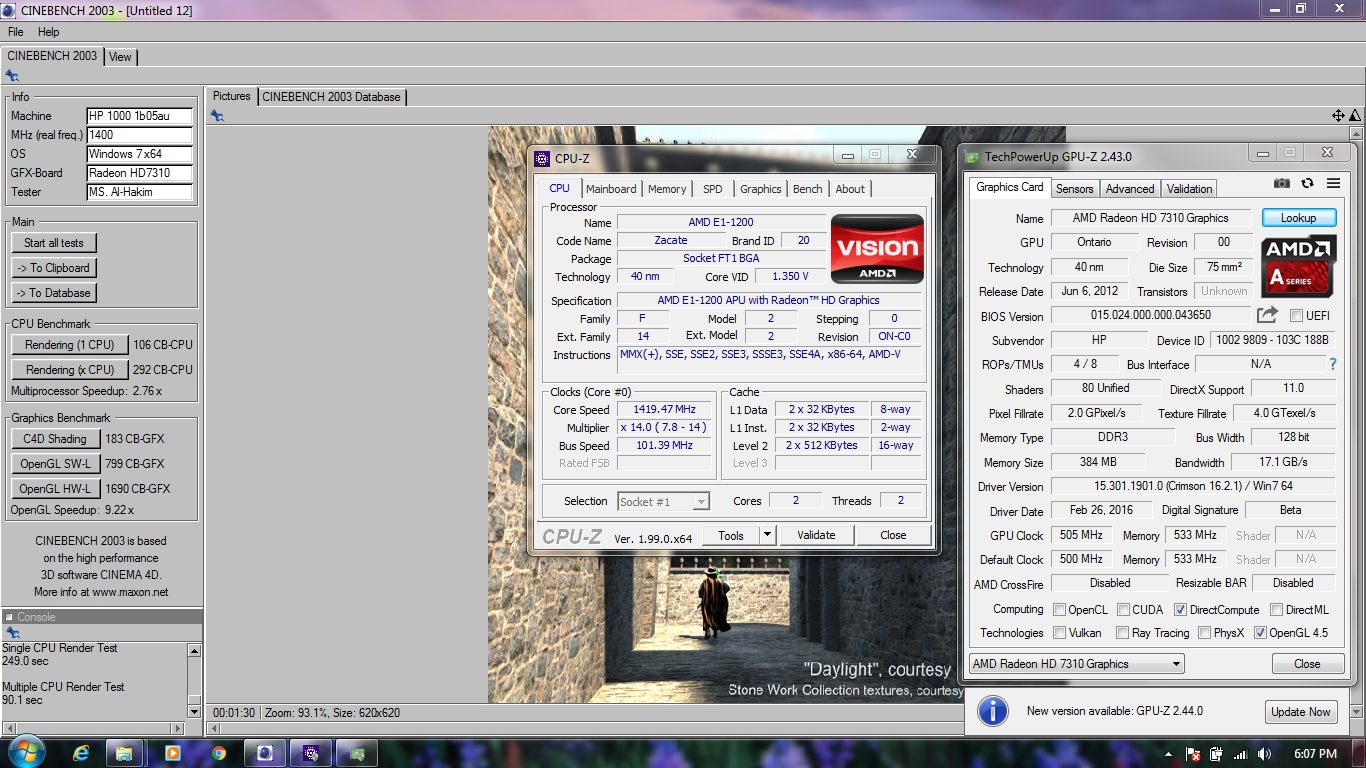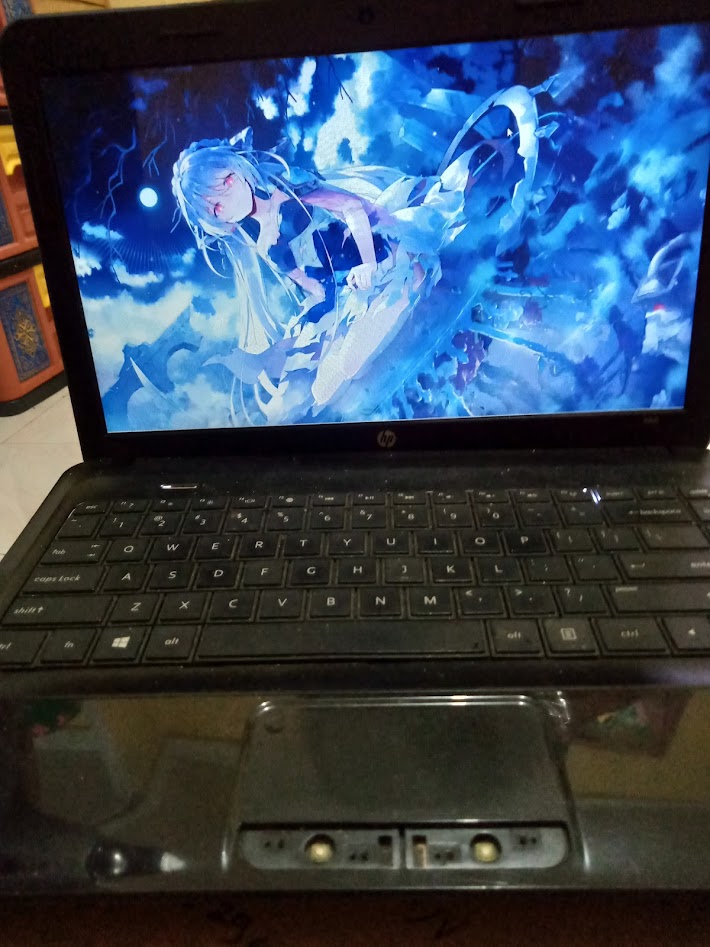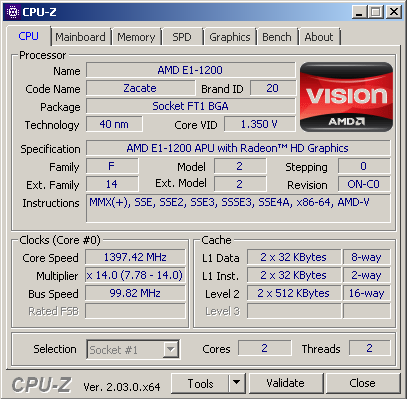Cinebench - 2003 score 292 cb with a E1-1200
Thursday, 01 January 1970 07:00 | Update at null
Media Gallery
Screenshot

Device, Setup, etc



URL
https://hwbot.org/submission/4941863https://www.facebook.com/hakimnu.id/posts/3209727832593191
Information Detail
Hardware: AMD E1-1200
Specs:CPUID : AMD E1-1200 APU with Radeon(TM) HD Graphics
Architecture : x86
Codename : Zacate
L3 Cache : -
Clock : 1.4GHz
Core/Thread : 2/2
TDP : 18W
Technology : 40nm
Socket : FT1 BGA 413-Ball
IGPU : AMD Radeon HD 7310
See more specification...
Software: Cinebench - 2003
Score: 292 cb
About: Cinebench - 2003Cinebench 2003 is one of the early versions of the Cinebench suite of benchmark tools based on CINEMA 4D Release 8 software, a professional 3D application from MAXON. Although it's relatively old, Cinebench 2003 is still used by some tech enthusiasts and overclockers as a historical performance reference and comparison of processor architectures over time. The application is available for free and is compatible with both Windows and Mac OS operating systems.
This benchmark tests system performance through several rendering and graphics processing scenarios. The main test in Cinebench 2003 involves rendering 3D scenes using the CPU, which can measure the efficiency and computing power of up to 16 processor cores in a single system. The results are measured in the form of a score-the higher the score, the faster the processor completes the render job. This is very useful for evaluating the multi-core capabilities of CPUs, especially on early generation processors that are starting to support multiple cores.
In addition to CPU testing, Cinebench 2003 also includes an OpenGL-based graphics test, where thousands of animated polygons are rendered in real-time to assess the GPU's ability to handle complex graphical displays. This test is important for users who want to understand how their system handles viewport-based graphics workloads, such as those often found in 3D design and modeling software.
Although it has been replaced by more modern Cinebench versions such as R15, R20, and R23, Cinebench 2003 still has historical and technical value. Many benchmark data collectors and retro hardware enthusiasts use this version to consistently test and compare the performance of older systems. With a long track record of use and transparent testing methods, Cinebench 2003 is still relevant as a reference tool to see the evolution of CPU and GPU performance over time.
Released in 2012 as part of the Brazos 2.0 family, the AMD E1-1200 is a power-efficient processor aimed at entry-level laptops. It has a 2 core and 2 thread configuration with a fixed clock speed of 1.4 GHz, with no support for Turbo Core technology. Built with a 40nm fabrication process, the E1-1200 has a TDP value of 18 watts-efficient enough for portable devices that emphasize low power consumption and longer battery life. Despite its limited performance, the E1-1200 was a popular choice in its day thanks to its affordable price and ability to handle light computing needs.
One of the main advantages of the AMD E1-1200 is the integrated Radeon HD 7310 GPU, which offers better graphics performance than Intel's entry-level graphics solutions at the time. This GPU has the ability to play HD resolution videos smoothly, as well as run light games such as Counter Strike 1.6, Plants vs Zombies, or other casual games with minimum graphics settings. That said, this combination of CPU and GPU is not intended for heavy-duty work such as video editing, 3D rendering, or modern gaming. Overall performance is more optimal when used for tasks such as browsing, streaming videos, accessing social media, typing documents, as well as basic office applications.
However, it should be noted that the AMD E1-1200 is less suitable for heavy multitasking, especially in modern operating systems like Windows 10. With a low clock speed and no Boost feature, users may experience lag or limitations when opening multiple applications at once. In tests using the HP 1000 1b05au laptop, this processor was paired with 4GB DDR3 single channel RAM (2 DIMM slots) and tested on Windows 7, Windows 8, and Windows 10 operating systems. The results show that the most optimal performance is achieved on Windows 7 or Windows 8, while in Windows 10 the system tends to be slow although it can still be used for basic needs. As such, the AMD E1-1200 can still be relied upon as a power-efficient and inexpensive solution for users with very light computing needs.
Hardware Detail:
Device: HP 1000 1b05au
RAM: 4GB DDR3 Single Channel 2 DIMM
OS: Windows 7, Windows 8, Windows 10
* Not Avaiable
